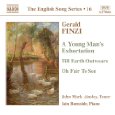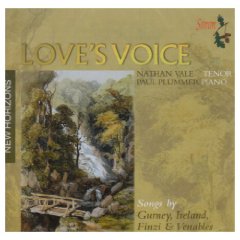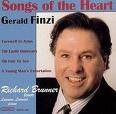Harvest
Poet: Edmund Blunden
Date of poem: (undated)
Publication date: First published in: "The Adelphi, November 1924, Vol. 2, No. 6, p. 473." (Kirkpatrick, 332)
Publishers: Beaumont Press (Kirkpatrick, 18), Cobden-Sanderson (Kirkpatrick, 21, 43), and Collins Clear-Type Press (Kirkpatrick, 111)
Collection: reprinted: Masks of Time (1925), English Poems (1926), The Poems (1930), and Poems of Many Years (1957). (Kirkpatrick, 332)
Poem: The poem is protected by copyright and therefore cannot be displayed.
Content/Meaning of the Poem:
1st stanza: While considering the last twelve months of my life, I ponder the successes and wonder how much more potential I have if I will only seize it.
2nd stanza: While viewing my life I see some unsuccessful opportunities, I wish they would have gone well because at the time I thought they were good for me. When things are new they seem good but the mountain top experience cannot be sustained and so they are thrown shortly on the fire.
3rd stanza: I look even deeper at my life and anxiously weigh it on the scale. It is not time to cash in because there is still too much clutter; the distractions are great and they easily can sway me from my original path.
4th stanza: I realize that so much is offered from this existence, I can choose from the banquet and grow fat if I want and this world will remain the same with or without me.
gleanings - things found or acquired by gleaning (glean - to gather slowly and laboriously, bit by bit.)
Unusual text found in the poem:
feign - to represent fictitiously or imitate deceptively.
imbrowned - made brown or dark.
Michaelmas - a festival celebrated on September 29 in honor of the archangel Michael.
sheaves - wheat, rye or other grain plants bundled together.
spires - tall and acutely pointed construction such as stalks of corn or wheat bundled together standing upright.
stooks - to stack sheaves of grain; form a pile of straw.
Speaker: Indiscriminate - possibly the poet, Edmund Blunden
Setting: Nothing specific but one may consider an appropriate setting to be anywhere one may evaluate their own life. A yearly pilgrimage in which the speaker surveys what has happened in his/her life is one possible setting.
Purpose: Taking stock of ones life.
Idea or theme: Life
Style: Written in a pastoral lyrical style.
Form: Four stanzas of six lines each. Lines one, two, three, four, and six in each stanza have are Iambic pentameter. The fifth line in each stanza is somewhat different. The fifth line in the first and forth stanza utilize Iambic trimeter while the fifth line in the second and third stanza utilizes Iambic dimeter.
Synthesis: There is much to consider in this poem in the way of metaphor, there are numerous uses of nature and one must consider whether or not they should all be considered as metaphor or a more simpler explanation of a pastoral landscape. The twenty-four lines could simply be reduced to one viewing ones life and realizing opportunities have been missed while others have been taken. The poem reminds oneself that in the greater scheme of things one's life is unimportant in this world, it is only important to the individual. The poem certainly possesses a narcissistic tone but perhaps Blunden wanted to remind the reader to live ones life full and free without worrying about what kind of legacy one may or may not leave humanity. The title "Harvest" as well as the pastoral lyrics Blunden chose reminds one of the harvest time with its vivid descriptions of "wry wheat, shrivelled fruits, berries, fields, gleanings" but these lyrics obviously are here to attempt to reach a more visceral layer. For example, the harvest time can bring mixed emotions and anxious anticipation of joy if it is a good harvest and disappointment if things don't turn out well. With the opening line, "So there's my year" the reader is challenged to look deeper into one's life and consider what has been accomplished, has one made good choices or has one missed opportunity and therefore there are regrets. "Harvest" reminds the reader of all of these and then concludes with a line that could easily have been a Thomas Hardy lyric, "And Earth accuses none that goes among her stooks."
Personal observation of Finzi's choice in poetry: The message of living life to the fullest is a common theme amongst the poetry that Gerald Finzi chose to set. This was obviously a theme that resonated with Finzi, perhaps he wanted more freedom in his own life. One can certainly see glimpses of him, Finzi seeking freedom in his choice to not pursue a more formal education and we also see it in his choice to live in the country instead of London or a more metropolitan area. The choice to live one's life full and free was also one often made in the poetry of Thomas Hardy and perhaps that is why Finzi gravitated so often to him for his muse.
✦✼✦✼✦✼✦✼✦✼✦✼✦✼✦✼✦✼✦✼✦✼✦✼✦✼✦✼✦✼✦✼✦✼✦
Musical Analysis
Composition date: 1956 (McVeagh, 260)
Publication date: First published 1965 - © Copyright 1966 by Boosey and Co. Ltd.
Publisher: Boosey & Hawkes - distributed by Hal Leonard Corporation
Tonality: The song begins in D minor and ends in D major but in between there is ample use of chromaticism.
Transposition: The song is available a minor third lower than the original key. The transposed version may be found in the Medium/Low Voice edition by Boosey & Hawkes entitled: Gerald Finzi Collected Songs 54 Songs Including 8 Cycles or Sets.
Duration: Approximately four minutes and nineteen seconds.
Meter: There are several different indications of various meter used within the song. 'Harvest' begins in 4/4 but in measure three Finzi utilizes 5/8 for one measure before returning to 4/4. In measure six we find one measure of 5/4 but then Finzi returns to 4/4 but only for one measure. In measure eight we once again encounter 5/8 for a single measure. In measure nine Finzi uses 3/4 for the first time in the song and remains in that meter until measure 14 where we find 2/4 for a single measure. In measure fifteen there is a single measure of 4/4 followed by 3/4 in measure sixteen. In measure seventeen we find 4/4 for a single measure before a single measure of 5/4 in measure eighteen after which the meter shifts lessen. In measure nineteen we encounter 4/4 and it remains in effect until measure twenty-four where there is a single measure of 5/4. Beginning in measure twenty-five there are three measures of 3/4 before returning to 4/4 in measure twenty-eight. In measure thirty-three 3/4 is indicated and remains so until the returning to 4/4 in the last measure, measure thirty-five.
Tempo: Andante espressivo with the quarter note equalling sixty is indicated. Beyond the opening indication of tempo there is a ritard indicated above the vocal line in measure twenty-seven. A tempo is indicated in at the pick-up to measure thirty-one. There is an accelerando indicated in the middle of measure fifty-two immediately followed at the downbeat of measure fifty-three with an a tempo indication. No other indications for tempo deviation occur within the song and in fact there is no ritard as one might expect at the end of the song with the soft pianissimo dynamic.
Form: The song is through-composed but the opening theme is repeated a few times before the beginning of the second stanza (see measures 1, 2, 7, and 15 below).
Thematic material in measure 1. (Finzi, 79)
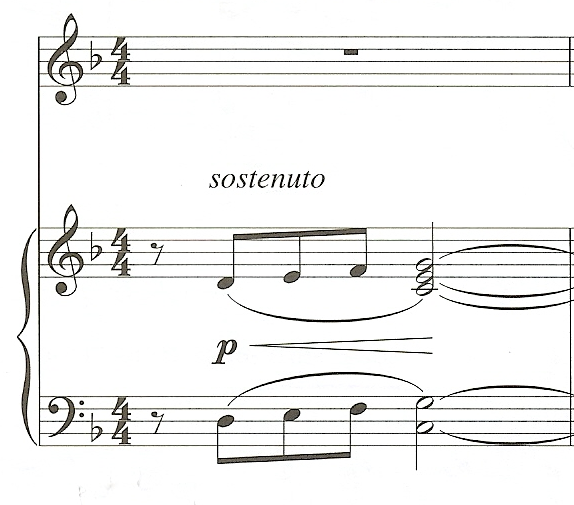
Thematic material in measure 2. (Finzi, 79)
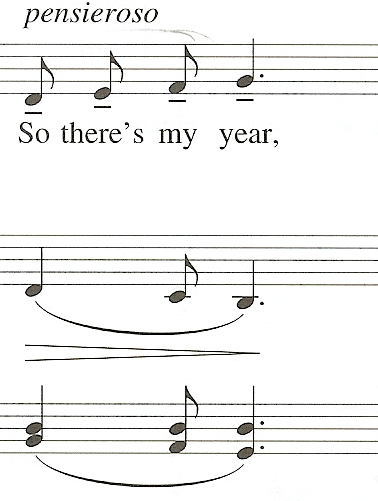
Thematic material in measure 7. (Finzi, 79)
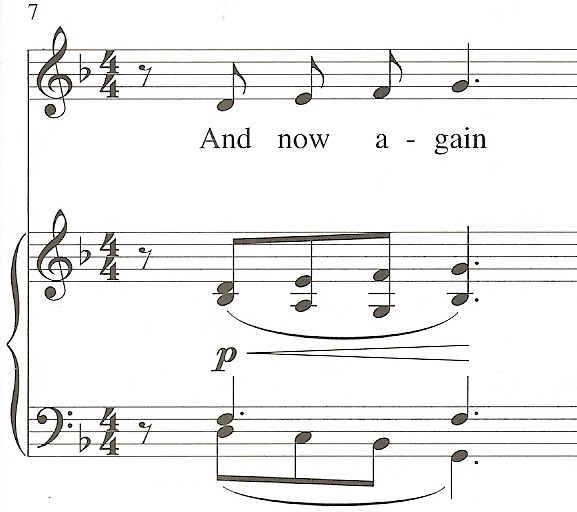
Thematic material in measure 15. (Finzi, 80)
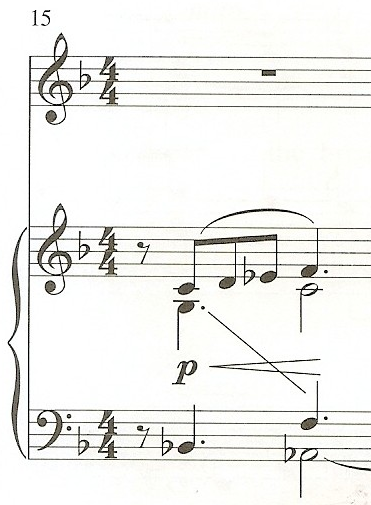
The four stanzas of the poem each have different material in the vocal line but the piano accompaniment of the fourth stanza, measures 44-9, is reminiscent of a portion within the middle of the second stanza, measures 22-4, in the left hand in particular (see examples below).
Accompaniment in measures 44-9. (Finzi, 82-3)


Accompaniment in measures 22-4. (Finzi, 80-1)

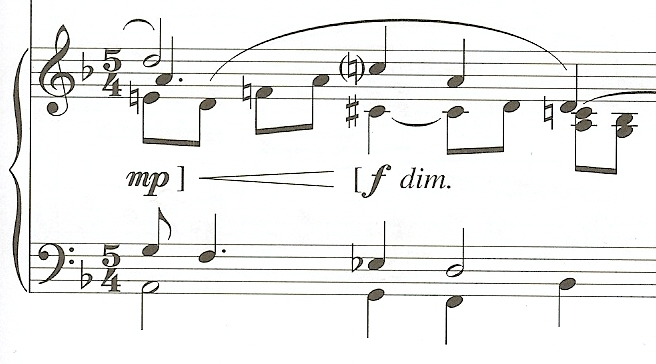
The two stanzas are quite dissimilar in almost all other material and therefore the similarities can be explained, as imitation of the bass motion.
Rhythm: A rhythmic duration analysis was performed and for the results please refer to: Rhythm Analysis. Information contained within the analysis includes: the number of occurrences a specific rhythmic duration was used; the phrase in which it occurred; the total number of occurrences in the entire song. The results from the analysis were used to make the following observations: In the first stanza one will find predominately eighth notes broken up with either sixteenth, quarter, or dotted quarter. In the second stanza the eighth note is still the dominate rhythmic duration but there is a little more variety than the first stanza. The third stanza begins rather slowly with more emphasis on longer note values and fewer eighth notes but this pattern is altered rather abruptly at measure thirty-six when Finzi shifts to sixteenth notes to quickly propel the text. The forth stanza in comparison to the second is quite similar in rhythmic duration values but it has a more angular rhythmic feel that the second. The angularity can be explained when one considers the frequent use of tying over notes interspersed with eighth and sixteenth note durations. There is an example of one rhythmic pattern that is used in all four stanzas of the song and it can be described as: an eighth note, dotted eighth, sixteenth, followed by two eighths. This rhythmic pattern occurs in measures 3-4, 5, 19, 46-7, 54-5 and twice as fast in measures 36-7 (see examples below).
Rhythmic pattern in measures 3-4 (Finzi, 79)

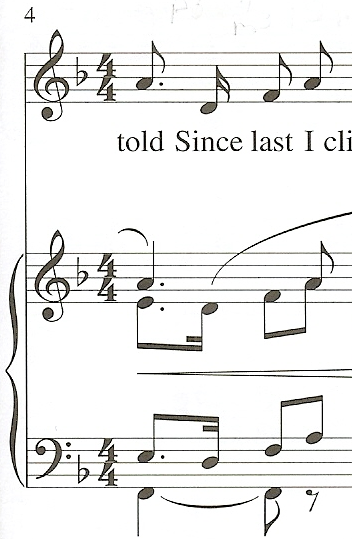
Rhythmic pattern in measure 5 (Finzi, 79)
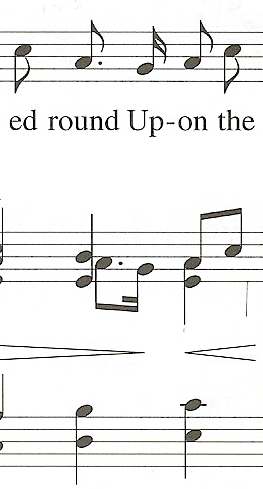
Rhythmic pattern in measure 19 (Finzi, 80)
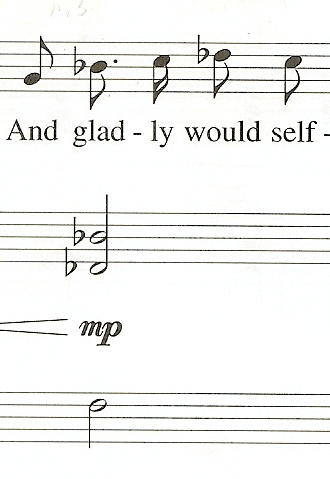
Rhythmic pattern in measures 46-7 (Finzi, 82-3)
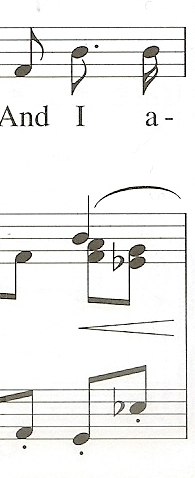
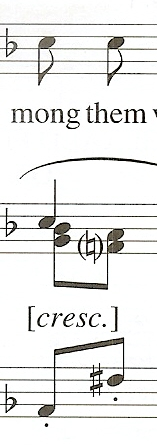
Rhythmic pattern in measures 54-5 (Finzi, 83)
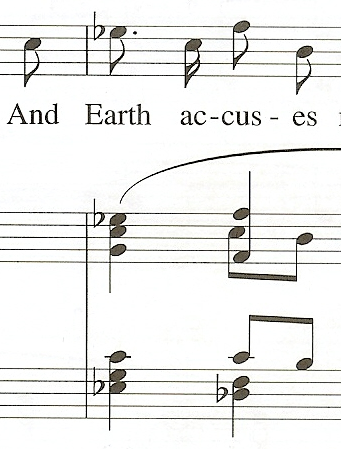
Rhythmic pattern twice as fast in measures 36-7 (Finzi, 82)
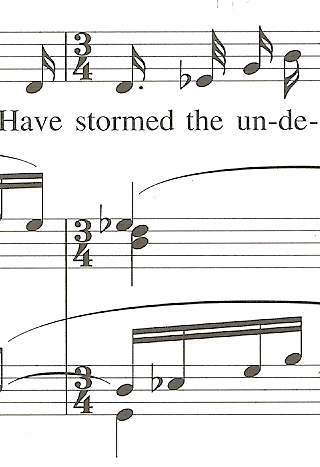
The third stanza has one single occurrence while the other three stanzas each have two. There are no unusual rhythmic patterns within the song but those used by Finzi to set the text again show his skill at setting it idiomatically. His use of rhythm is subtle and does not draw attention to itself which was obviously his intentions. Whether or not he labored over his text setting is not completely known but we do know from statements made by his wife, Joyce and others that he wasn't satisfied with the text unless it seemed perfectly natural. This drive to create a natural declamation of text was also part of his choice often in determining the melody of the vocal line.
Melody: An interval analysis was performed for the purpose of discovering the number of occurrences specific intervals were used and also to see the similarities if there were any between stanzas. Only intervals larger than a major second were accounted for in the interval analysis. For a complete description of the results of the interval analysis please refer to: Interval Analysis. A typical Finzi melody is one predominately made up of step-wise motion interspersed with occasional intervals larger than a third and this song is not an exception to that pattern but there are certainly moments that are not predominately step wise. The more disjunct melodic material occurs in measures 4-6 in the first stanza, measures 24-6 in the second, less so in measures 36-7 in the third stanza, and measures 53-5 in the last stanza (see examples below).
Disjunct melodic material in measures 4-6. (Finzi, 79)
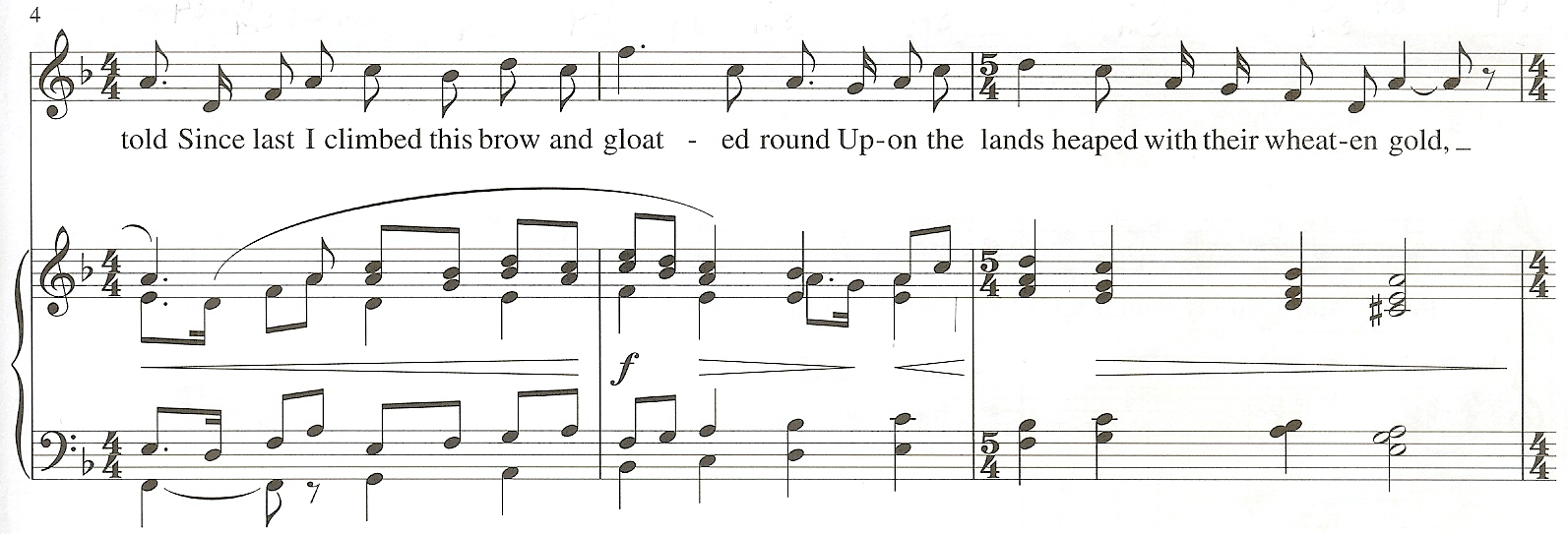
Disjunct melodic material in measures 24-6. (Finzi, 81)
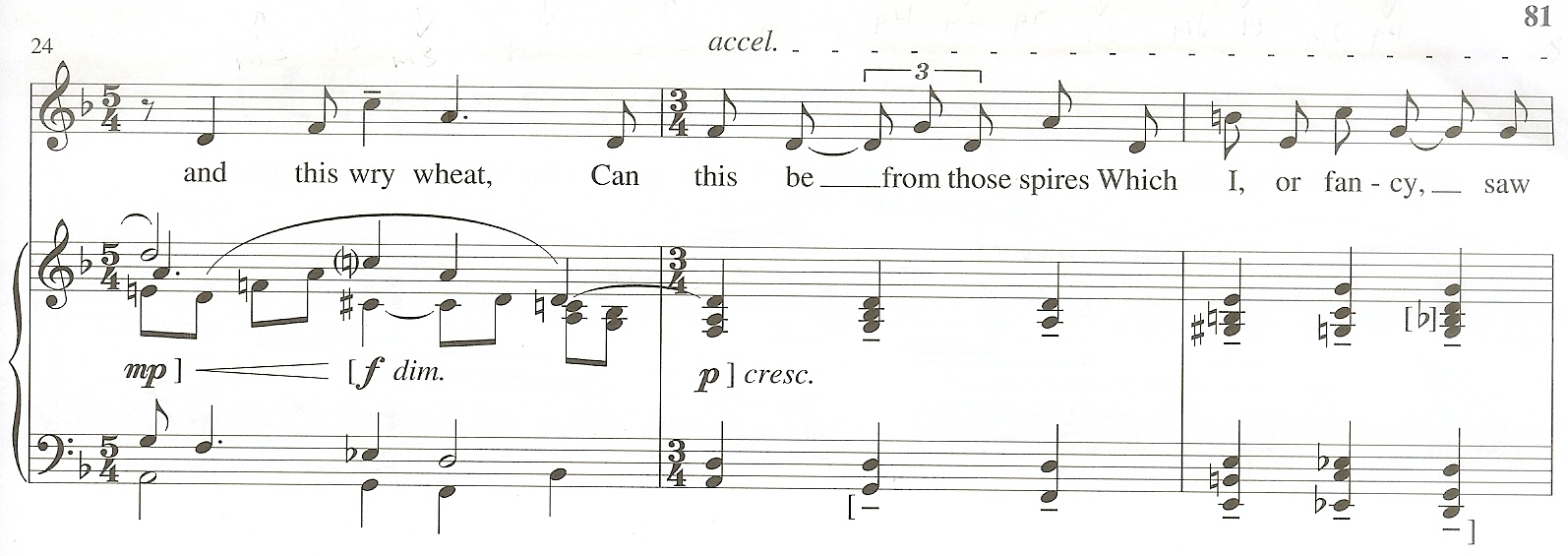
Disjunct melodic material in measures 36-7. (Finzi, 82)
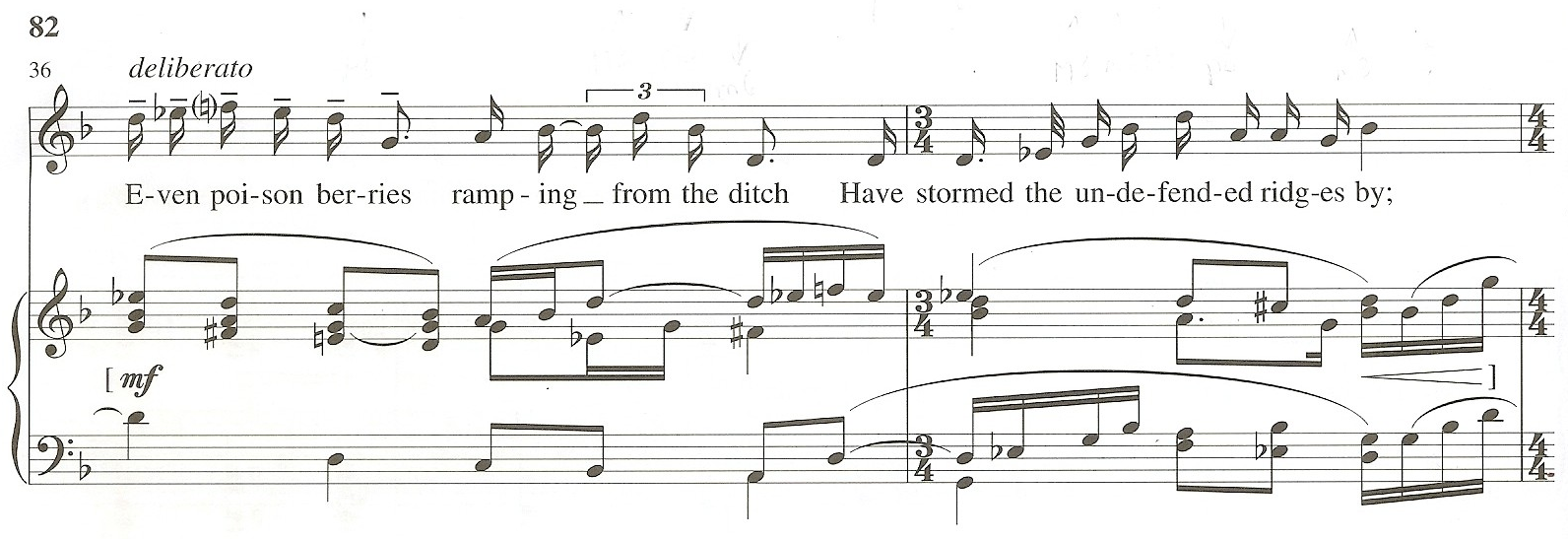
Disjunct melodic material in measures 52-5. (Finzi, 83)
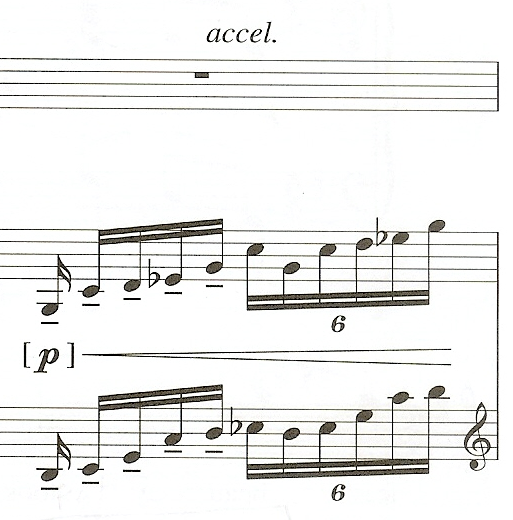

One possible explanation as to why Finzi wrote with a less conjunct melody than his norm might be his intention to create greater melodic tension which correspondingly contributed to a sensation of propelling the text or momentum in the song. Finzi according to several scholars of his work including his best friend as well as colleague, Howard Ferguson, had a rather difficult time writing music that was of a quicker more up tempo nature and perhaps this song was an experiment. Another explanation could also be that this is one of his last songs coming only months before his death in 1956 and again perhaps he was simply experimenting with less conjunct melodies for the purpose of greater expression.
As was noted in the rhythm section above, the third stanza in this song is quite different than Finzi's standard fare and through the intervallic analysis it was noted that there are single occurrences of a minor and major sevenths within this stanza. The interval of a minor seventh is not extremely common for Finzi but it can be found also in "As I lay in the early sun" (occurring downward), "At a Lunar Eclipse" (downward), "The Market-Girl" (upward and downward) and "Since we loved" (upward). Out of the twenty-four songs analyzed as part of this project the interval of the major seventh can only be found in this song. The interval begins the third stanza in measures 30-1 on the text "I peer" (see example below).
Major seventh in measures 30-1. (Finzi, 81)
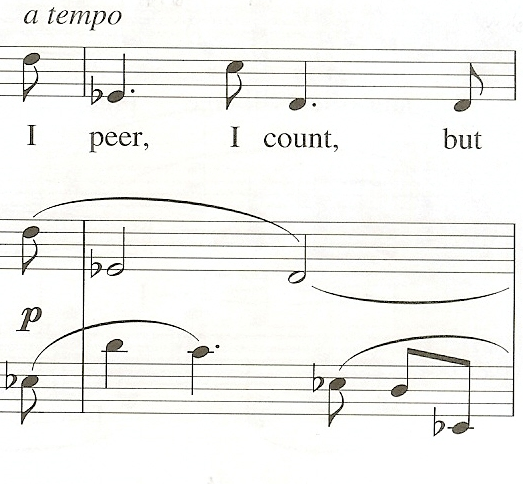
Within the third stanza also there are more occurrences of larger intervals than major and minor thirds which is not common in most Finzi songs. The third stanza also possesses a great number of sixteenth and dotted sixteenth notes therefore combining the shorter note values with the larger leaps (see example below).
Use of sixteenth and dotted sixteenth notes. (Finzi, 82)

One could possibly conclude that Finzi was attempting to create much more drama in this stanza than the other three. The text in the third stanza, which is always a catalyst for Finzi's composition, displays a number of questions in an attempt to examine one's life. One could make an argument that Finzi was attempting to create so much tension in this stanza so as to lead one to think that the speaker was resisting being examined by himself. If this is the case, Finzi calms the waters by the end of the stanza and remains subdued until one last outburst of passion in the fourth stanza in measures 52-5 (see example below).
Excited outburst of passion in measures 52-9. (Finzi, 83)



The excited outburst begins in the piano accompaniment but soon the vocal line adopts the demand as well before quieting itself once again in the last few measures as the song concludes. The song's melodic line vacillates between melodious and disjunct material but even when the melodic material is more disjunct the song remains tonal.
Texture: The song is primarily homophonic with some incidents of counterpoint.
Vocal Range: The vocal range spans the interval of a minor thirteenth. The lowest pitch is the C below middle C and the highest pitch is the A flat above middle C.
Tessitura: The tessitura of the song lies between the D below middle C and the F above middle C. For a complete pitch count for each stanza please refer to: Pitch Analysis.
Dynamic Range: The song begins with a soft piano dynamic but there are indications to swell immediately with a crescendo and decrescendo marking for the piano. There are frequent dynamic indications throughout the song but there are none for the vocal line. The climax of the song comes in measure fifty-four on the text, "laughing" with fortissimo indicated. Beyond the climax the other loudest moments in the song occur in measure five, on the text, "gloated;" in measure twenty-one, on the text, "bloom;" in measure twenty-three, on the text, "bright;" in measure twenty-four, there are indications for a forte dynamic as well as tenuto, on the text, "wry;" in measure twenty-seven, on the text, "leap;" in the piano accompaniment in measure thirty-eight, which was preceded by the text, "Have stormed the undefended ridges by;" the last indication of forte dynamic in the piano accompaniment occurs in measure fifty-three just prior to the climax in measure fifty-four which has already been previously mentioned. The softest dynamic is reserved for the piano postlude.
Accompaniment: The piano accompaniment is the most complex of any of the songs in the set 'Oh Fair to See.' The frequent meter shifts, and numerous dynamic and expression indications as well as the disjunct melodic material makes for a rather difficult accompaniment.
Published comments about the music: "'Harvest' offers a more familiar personality, but one tempered and made somewhat austere by Blunden's kind of introspection, compounded of curiosity and diffidence and with no capacity for Hardy's emotional melodrama and indulgence. The music on occasions seems to weigh out its notes and define its textures as economically as Blunden his words in his letters to Finzi, with an emphasis here and elsewhere on bare seconds. But this only throws the 'aria' resolution of the song's and the poem's problem into all the more delicious relief when it comes with a Purcellian refulgence that even Blunden the non-musician must have appreciated. Finzi never used this device more beautifully, and the image of the composer accepting his unfulfilled personal fate and descending the hill to enjoy nature's cornfields in harvest is not just a touching but an uncannily prescient one, given the role that both hill and cornfields were to play in Gerald's life the following month - his last."
(Banfield, 477-8)
Diane McVeagh writes in her biography for Gerald Finzi the following comments: "Finzi often employs recitative, arioso, sustained melody all in one short song. Usually recitative suggests questioning, and cantilena confirms certainty, as in the early song 'A young man's exhortation'. 'Harvest' (1956) is also discursive: it would seem unlikely that such a kaleidoscope of textures, figures, rhythms, and keys could combine into a unified song, philosophical as well as beautiful. It is a finer, more personal tribute to Blunden than For St. Cecilia. The song opens as if in mid-conversation, thoughtful and confiding, as the poet sadly reviews his lack of achievement; the motif at 'so there's my year' returns as the piano postlude; and only at the very end is regret dispelled by the first tonic major chord in the song. Often in his music Finzi marks intensity by a semitone clash, as is so poignant in 'Since we loved' (1956) - 'loved' is after all past tense. In 'Harvest' he uses the semitone thematically as well: vertically for instant effect on 'thriftless' (Ex. 16.a); elongated and in octave displacement at 'I peer' (b), clustered again at 'poison' (c); elongated and widened to introduce nature's consolation (d), then smoothed by passing notes for 'valleys sweet' (e), instant again for the piano's climactic chord in the bar after 'both feast and crown'.
(McVeagh, 260)
McVeagh continues with her comments about the song: "There are two remarkable visual images, the stoop at 'I peer' (Ex. 16.3b); and the jagged, rising, widening leaps to outline 'spires'. The singer's highest notes are carefully graded, f" for 'gloated', g" for 'bright', finally a" flat for 'laughing'. The imperfect cadence at 'what sheaves [have I] to pile?' as the poet/composer laments his incomplete harvest is resolved at the final 'goes among her stooks'. The song relaxes into Finzi's cantilena (Ex. 16.3e) as the poet gains comfort from earth's beauty, accepting his part in nature. Those are some of the sophisticated but probably intuitive means by which Finzi integrates this late fine song."
(McVeagh, 260)
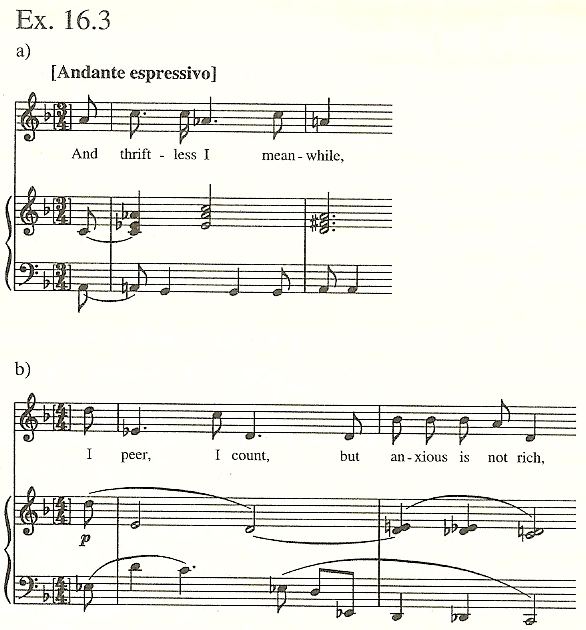
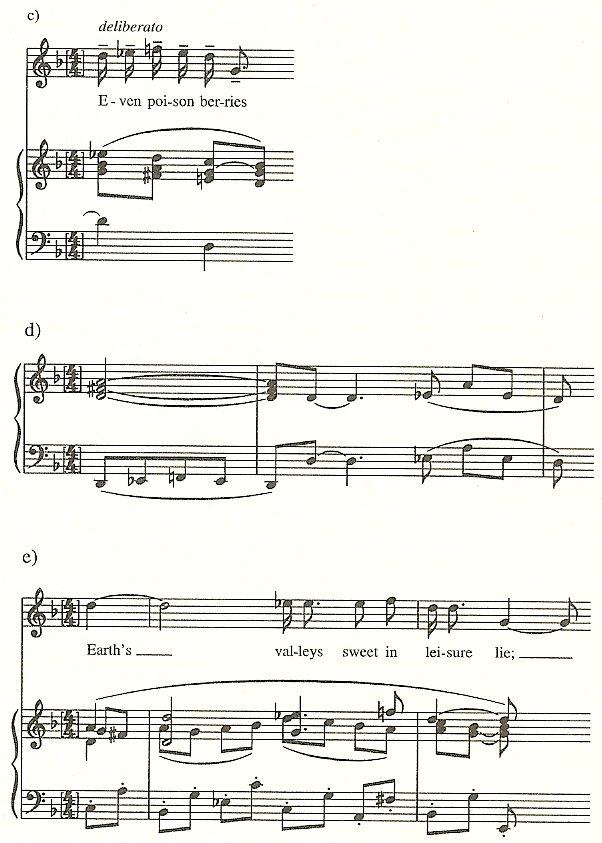
(McVeagh, 261)
Pedagogical Considerations for Voice Students and Instructors: This song, in the original key, could possibly be out of the reach of most young tenors with its wide range. Another concern, with regards to the range of this song, are the approaches to the high notes; most often they are leaps as wide as an octave. Another consideration when determining the appropriateness of this song for a student, is the text. The text seems more suited to an older student who has been exposed to life's "ups and downs." This song could be a good project for a student who is ready to take-on an English song that requires lyricism in the vocal line while declaiming a text with impeccable diction. With this in mind most younger students will struggle with the text more so than the range of this song.
A good approach to beginning work on this song will be to thoroughly familiarize oneself with the poetry, there a numerous metaphor references and one does a disservice to the poem if they are not discovered prior to work on the song. The next step would most likely involve declaiming the text in rhythm. The rhythms are not difficult but one should take the time to learn cleanly the text with rhythms before attempting to sing the melody. Once the diction and rhythm are good and clean one may begin working on some of the more difficult approaches to some of the high notes in the song. The first one occurs in measure five on the word "gloated." The [gl] consonant combination should be lightly stroked so as to prevent tongue tension. Another potentially difficult spot in the song occurs in measures twenty and twenty-one with the text "The bloom smelled heavenly." There are a few pedagogical considerations with this section. First, the leap of an octave and the need to sustain an [oo] vowel on an [f] above middle [c]. If the student seems to choke on the vowel one might make the suggestion to envision inhaling the vowel while sustaining. If this doesn't seem to work try first an octave leap a little lower but it is imperative that the upper note must reside in the passaggio so the student learns to negotiate the release of the heavier chest voice. Once the student is more comfortable with the leap and vowel have them sing the rest of the measure while monitoring the breath flow. Some students may elevate the larynx while singing this passage so it needs to be closely watched. In measure twenty-three, the singer is given an optional note on the word "bright." If the [g] is difficult for the student have them sing the phrase several times using the optional [d] and once the line is more fluid and free of tension attempt the [g]. This may require going back and forth several times until the [g] is more in-line with the whole phrase.
Measures twenty-five through twenty-eight are particularly difficult with the disjunct melodic movement as well as the sustained [g] on the word "leap." This section can also be challenging for the breath support needed to complete the phrase. In planning the breaths for the phrase one may attempt to take a quick breath before the word "Which" in measure twenty-five. Ideally one should not breathe before "to the spring sun's fires" but while working this section one will probably feel the need to take a breath after "leap." Another potentially difficult passage occurs in measure forty-seven with the text "them wandering." Some students may attempt to "grip" when approaching the leap on "wandering." If this occurs one remedy may involve asking them to substitute the consonant [f] in place of the [w] until the breath flows more evenly and the urge to "grip" discontinues. The highest pitch in the song occurs in measure fifty-four on an [A-flat] above middle [c]. It should not be problematic for most tenors as it is a brief sixteenth note but it does involve an [l] consonant in the word "laughing." A good approach to negotiating the high-note will be to monitor the use of the tongue on the [l] consonant and to make sure it is lightly articulated.
An overall suggestion when working on this song involves monitoring the breath flow while declaiming the text. This song will be extremely challenging for most students to master the lyricism needed while articulating the text but if the range is not an issue they may discover the challenge to be very rewarding.
✦✼✦✼✦✼✦✼✦✼✦✼✦✼✦✼✦✼✦✼✦✼✦✼✦✼✦✼✦✼✦✼✦✼✦
✦✼✦✼✦✼✦✼✦✼✦✼✦✼✦✼✦✼✦✼✦✼✦✼✦✼✦✼✦✼✦✼✦✼✦
Audio Recordings
The English Song Series - 16 |
|
|
|
Love's Voice |
|
|
|
Song Cycles for Tenor & Piano by Gerald Finzi |
|
|
|
Song by Finzi and His Friends |
|
|
|
Oh Fair to See: Songs by English composers |
|
|
|
Songs of the Heart: Song Cycles of Gerald Finzi |
|
|
|

